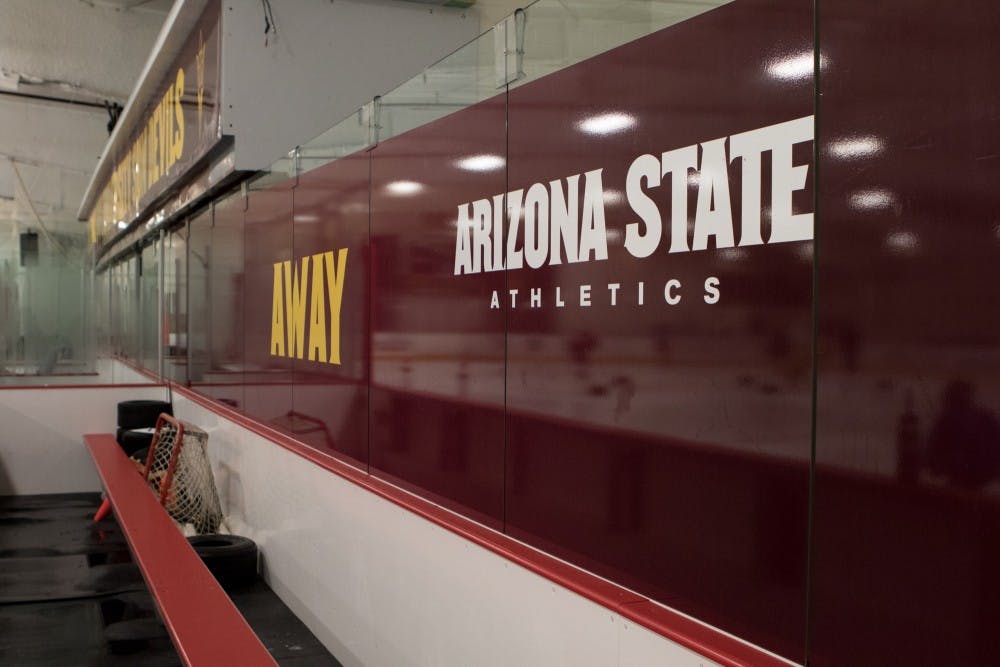Money talks, and change breeds momentum.
Such was the case last November, when a $32 million donation by donor Don Mullet paved the way for ASU's newest sport — men's ice hockey.
The program, of course, already had momentum on its side. Just months earlier, the then-ACHA club program clinched the first national title in program history. The banner to commemorate that feat had just been raised inside the club's home facility, Oceanside Ice Arena.
Just over a month away from its NCAA debut, the arena no longer has the banner raised.
"This is a whole other ballgame," Adam Mims, executive director for Oceanside Ice Arena, said. "The NCAA team is not sitting back saying, 'We did so good in ACHA.' This is a whole new deal. The NCAA program wants to have success on a national level, and the ACHA, that's in the past."
Part of moving forward means that the arena, which previously held just 800 fans on wooden bleachers, would undergo a massive renovation. All without seeing a single dime of that $32 million.
Among the renovations are a brand-new maroon bleachers that go five rows up and will wrap around the ice to expand attendance, a new "Inferno" student section, new paint, Adidas and ASU branding, a new locker room, a new media room and a players lounge stocked with leather couches, flat-screen TVs, an XBOX and a ping pong table.
Why? The program, which will already play four of its 15 home games (the other 11 have been confirmed for Oceanside) at Glendale's Gila River Arena instead of its home ice, is still looking for a new permanent facility, and Oceanside will not be able to sustain a full NCAA program.
"We know the program won't stay at Oceanside in two years," Mims said. "We know the NCAA program will leave, and we're happy about that. We're happy for them to transition onto the next bigger arena. But for us as a youth hockey association and for the club teams, it benefits us greatly to even closer align ourselves with ASU and the Sun Devil brand."
Mims, as well as others who have been part of the transition, are hoping to succeed where previous NCAA programs on the west coast did not. In doing so, they will defeat a nagging stigma that hockey will not work in a desert climate.
However, in the past few months, such claims have been proven wrong locally.
The NHL's Arizona Coyotes, who play at Gila River Arena, appeared to be destined to leave town for the umpteenth consecutive offseason until local fans gathered support.
ASU hockey announced their NCAA transition to positive appraisal, with the stepping stones being placed to expand the Pac-12 Networks' brand to include hockey on the west coast.
The newly-renovated Oceanside Ice Arena has just 90 of its 800 total season ticket sales remaining, Mims said.
"The old mind set that hockey doesn't work in warm climates is silly," he said. "Hockey absolutely does work in warm climates and non-traditional environments. It's an exciting sport, kids love it, it's exciting to watch — especially live — and there's no reason it won't continue to grow."
In addition to the new NCAA program, ASU will continue its club ACHA program at Oceanside along with the advent of the ASU women's club ice hockey program that is set to launch in 2016.
The program, while being a club team and not being affiliated with Sun Devil athletics, is the latest step in developing a hockey culture in the desert. It's a project that has gone on for six months behind the scenes, Mims said.
"(Club president) Lindsey Ellis has done a really good job getting that off the ground," he said.
In addition, the local youth hockey program has rebranded themselves to become the Jr. Sun Devils, the first youth program to ever be granted licensing by ASU.
It's clear that the renovations are about more than just NCAA hockey — it's about developing a hockey culture in a state that traditionally has had difficulty adapting in the past.
Oceanside Ice Arena wants hockey in the desert to happen.
This, of course, means that it is on the NCAA team to set the bar.
"We're the first Pac-12 school to make the jump (to NCAA) and I think guys at Oregon, guys at UCLA, guys at USC, they're going to take note of this first year and see how it goes," said junior forward Michael Cummings, who is one of the holdovers from the ACHA program. "Hopefully it'll progress into something bigger."
Having a chance to build something new in the recreated arena has been a draw to recruits who likely would not have otherwise chosen ASU, such as freshman forward Louie Rowe.
"I think this program is ready to blast off and be one of the top programs in the country," Rowe said. "Just starting the tradition. I wanted to be one of the first ones. When I'm older and have kids and stuff, I can tell them that I was the first year. I helped build this program. I was one of the very first students to ever commit here, so it's kind of an honor to be one of the first."
ASU head coach Greg Powers' slogan for the program's inaugural NCAA season reads "Be The Tradition."
Now, with a newly renovated arena and ecstatic fan base, it's time to go make it happen.
Related Links:
ASU hockey to call Oceanside home another season
ASU hockey team behind growing popularity of sport in desert
Reach the reporter at fardaya@asu.edu or follow @fardaya15 on Twitter.
Like State Press Sports on Facebook and follow @statepresssport on Twitter.




